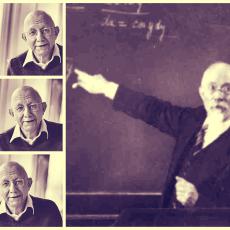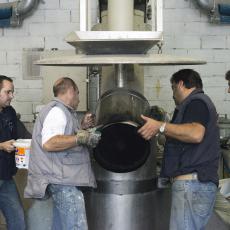Venezuela: Class Struggle Heats Up Over Battle for Workers’ Control
On July 22, Venezuelan President Hugo Chavez again declared his complete support for the proposal by industrial workers for a new model of production based on workers’ control. This push from Chavez, part of the socialist revolution, aims at transforming Venezuela’s basic industry. However, it faces resistance from within the state bureaucracy and the revolutionary movement.
Presenting his government’s “Plan Socialist Guayana 2009-2019,” Chavez said the state-owned companies in basic industry have to be transformed into “socialist companies.” The plan was the result of several weeks of intense discussion among revolutionary workers from the Venezuelan Corporation of Guayana (CVG). The CVG includes 15 state-owned companies in the industrial Guayana region involved in steel, iron ore, mineral and aluminium production.
The workers’ roundtables were established after a May 21 workshop, where industrial workers raised radical proposals for the socialist transformation of basic industry. Chavez addressed the workshop in support of many of the proposals. But events between the May 21 workshop and Chavez’s July 22 recent announcement reveal much of the nature of the class struggle inside revolutionary Venezuela.
Chavez’s announcement is part of an offensive launched after the revolutionary forces won the February 15 referendum on the back of a big organisational push that involved hundreds of thousands of people in the campaign. The vote was to amend the constitution to allow elected officials to stand for re-election – allowing Chavez, the undisputed leader of the Venezuelan revolution, to stand for president in 2012.
With oil revenue drying up due to the global economic crisis, the government is using this new position of strength to tackle corruption and bureaucracy, while increasing state control over strategic economic sectors. This aims to ensure the poor are not made to pay for the crisis.
WORKERS’ CONTROL
On May 21, Chavez publicly threw his lot in with the Guayana workers, announcing his government’s granting of demands for better conditions in state-owned companies and the nationalisation of a number of private companies whose workers were involved in industrial disputes.
“When the working class roars, the capitalists tremble”, Chavez told the crowd. To chants of “this is how you govern,” Chavez announced his agreement with a series of measures proposed by workers.
However, like an old train that begins to rattle loudly as it speeds up, more right-wing sectors within the revolutionary movement also began to tremble. With each new attack against the political and economic power that the capitalist class still holds in Venezuela – and uses to destabilise the country – the revolution is also forced to confront internal enemies.
The radical measures announced at the May 21 workshop were the result of the workers discussion over the previous two days. Chavez called on workers to wage an all-out struggle against the “mafias” rife in the management of state companies. Chavez then designated planning minister Jorge Giordani and labour minister Maria Cristina Iglesias, who both played a key role in the workshop, to follow up these decisions by establishing a series of workers’ roundtables in the CVG industries.
The CVG complex is on the verge of collapse in large part due to the privatisation push by pre-Chavez governments in the 1990s. State companies were run down in preparation to be sold off cheaply. In the Sidor steel plant, for example, the number of workers dropped from more than 30,000 to less than 15,000 before it was privatised in 1998. Chavez’s 1998 election stopped further privatisation. But the government has had to confront large scale corruption within the CVG, continued deterioration of machinery and, more recently, the sharp drop in prices of aluminium and steel.
The plan drafted by workers and given to Chavez on June 9 raised the possibility of “converting the current structural crisis of capitalism” into “an opportunity” for workers to move forward in “the construction of socialism, by assuming in a direct manner, control over production of the basic companies in the region.” The report set out nine strategic lines – including workers’ control of production; improvement of environmental and work conditions; and public auditing of companies and projects.
Measures proposed include the election of managers and management restructuring; collective decision-making by workers and local communities; the creation of workers’ councils; and opening companies’ books. The measures aim to achieve “direct control of production without mediations by a bureaucratic structure.” The report said such an experience of workers’ control would undoubtedly act as an example for workers in “companies in the public sector nationally, such as those linked to hydrocarbons or energy companies.”
BUREAUCRACY BITES BACK
Sensing the danger such an example represents to its interests, bureaucratic sections within the revolutionary movement, as well as the U.S.-backed counter-revolutionary opposition, moved quickly to try and stop this process. A wave of strikes and protests were organised in the aluminium sector during June and July, taking advantage of workers’ disgruntlement with corrupt managers and payments owed. The protests were organised by union leaders from both the Socialist Bolivarian Force of Workers (FSBT), a union current within the mass party led by Chavez, the United Socialist Party of Venezuela (PSUV), and those aligned with opposition parties such as Radical Cause.
Revolutionary workers from Guayana condemned the unholy alliance of bureaucratic union leaders and opposition political forces, which aimed to stifling the process initiated on May 21. This alliance was supported by Bolivar governor, retired General Francisco Rangel Gomez, who called on the national government to negotiate directly with local unions. Opinion pieces began to appear in the local press, calling on the government to once again make Rangel president of the CVG in order to bring ‘stability.’ The alliance between Rangel and union bureaucrats in Guayana is long running.
Officially part of the Chavista camp, Rangel has long been accused of being corrupt and anti-worker. During his term as CVG president before becoming governor in 2004, Rangel built up a corrupt clientalist network with local union and business figures. He stacked CVG management with business partners and friends. While on the negotiation commission to resolve the 15-month long dispute at Sidor, Rangel ordered the National Guard to fire on protesting Sidor workers.
Also on the commission was then-labour minister and former FSBT union leader from Guayana, Jose Ramon Rivero, who was similarly accused by Sidor workers of siding with management. He was also criticised for using his position as labour minister to build the FSBT’s bureaucratic powerbase by promoting ‘parallel unions’ along factional lines and splitting the revolutionary union confederation, National Union of Workers (UNT).
In April last year, Chavez disbanded the Sidor negotiation commission and sent his vice president, Ramon Carrizales to resolve the dispute by re-nationalising the steel plant. Rivero was then sacked. Today, he works as the general secretary in Rangel’s governorship. The forces behind Rivero and Rangel hoped not only to stifle the radical proposals from the May 21 workshop, but also remove basic industry minister Rodolfo Sanz.
Sanz has moved to replace Rangel’s people with his own in the CVG management. In the recent dispute, Sanz accused aluminium workers of being responsible for the crisis in that sector. He worked to undermine the proposals of the roundtable discussions. After several days of negotiations union leaders – essentially sidelining the workers roundtables – Sanz agreed on July 20 not only to pay the workers what they were owed, but also to restructure the board of directors in the aluminium sector.
Through this process, the radical proposals for restructuring the CVG appeared to have been pushed aside – which suited both Sanz and Rangel.
REVOLUTIONARY LEADERSHIP
However, Chavez intervened with his July 22 announcement, which came after a meeting with key ministers and advisors involved in the May 21 socialist transformation workshop. Chavez said his government was committed to implement the recommendations of the “Plan Socialist Guayana,” placing himself clearly on the side of the workers. He said the workers’ proposals, embodied in the plan, would “guide all the new policies and concrete and specific measures that we are beginning to decide in order to consolidate a socialist platform in Guayana.”
When a journalist directed her first question to Sanz regarding the plan, Chavez stepped in to respond, by-passing Sanz and handing the microphone over to Giordani, who many revolutionary workers identify as strongly committed to the process of socialist transformation. Rangel, who had been at the May 21 workshop, was not at the July 22 meeting.
Chavez also appeared to differentiate himself from other sectors within the revolutionary movement, such as those behind the “A Grain of Maize” daily column, whose authors are linked to a political current involving oil minister Rafael Ramirez. This current has recently been vocal in arguing that socialism simply entails state ownership and central planning from above – with minimum participation from workers.
For Chavez, state-owned companies “that continue to remain within the framework of state capitalism” have to be managed by their workers in order to become ‘socialist.’ The Plan Socialist Guayana is Venezuela’s first example of real “democratic planning from below,” Chavez added.
The battle in Guayana is not over. Workers from the Alcasa aluminium plant told Green Left Weekly that management at aluminium plants met on July 25 to continue the process of restructuring agreed to by Sanz and union leaders – in direct opposition to Chavez’s statements.
Other fronts of intense class conflict have opened up. Various struggles have emerged involving different forces and interests in the electricity sector, as well as the still-emerging communes, which unite the grassroots communal councils, to name a few.
A central arena of struggle is the PSUV, which is in a process of restructuring ahead of its second congress in October. But the battle in Guayana may be one of the most decisive as it involves the largest working-class population. This is in the context of a revolution whose weakest link has been the lack of a strong, organised revolutionary workers’ movement.






Comments
Post new comment